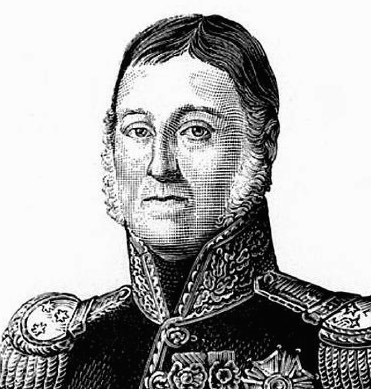General Pierre Hugues Victoire Merle

Born: August 26, 1766
Place of Birth: Montreuil-sur-Mer, Pas-de-Calais, France
Died: December 5, 1830
Place of Death: Lambesc, France
Arc de Triomphe: MERLE on the west pillar
Pronunciation:
The son of a miller, Pierre Huges Victoire Merle first enlisted in the infantry regiment of Foix at the young age of 14 in May of 1781. The next year he was dismissed for not being old enough, but he rejoined the army in 1784 and then he served with the regiment of Angoumois. Once the French Revolution was underway opportunities for promotion increased, and in June of 1792 Merle received a commission as a sous-lieutenant and then four months later he received a promotion to lieutenant. He initially served with the Army of the Pyrenees and after that army was split up he served with the Army of the Western Pyrenees. In the summer of 1793 Merle was elected a capitaine of cannoneers. In March of 1794 he was promoted to chef de bataillon and given command of a battalion of artillery at Bayonne. Only a few weeks later Merle was promoted to général de brigade and named the commander of Fort Socoa. That August he took command of the 1st Brigade of the 1st Division and then in November he served at the combat of Bergara.
In 1795 Merle bounced between brigades and served in the Army of the West and then at the beginning of 1796 he joined the Army of the Coasts of the Ocean. Later that year he was ordered to lead reinforcements to the Army of the Alps. Afterwards Merle served with the Army of the Alps and then he served in the 8th military division. In the year 1800 he was initially employed in the 17th military division but then in late May he joined the Army of the Reserve. That July Merle joined Boudet's division and the next year he took command of the 27th military division. In 1803 Merle transferred to the camp of Saint-Omer.
Taking part in the campaign of 1805 against the Third Coalition, Merle served with Legrand's division. After taking part in the fighting at the Battle of Austerlitz that December, he was promoted to général de division on Christmas Eve. In March of 1806 he became chief of staff to Marshal Soult's IV Corps and then in September he was named commander of Braunau.
Merle was sent to Spain in 1808, initially taking command of the 1st Division in Marshal Bessières corps. In June he seized Valladolid, Lantueno, and Santander, and then in July he fought at Medina del Rioseco . Rewards followed with Merle being named a Baron of the Empire and Grand Officer of the Legion of Honor. Next Merle took command of the 2nd Division and he fought at Logrono in October. In January of 1809 Merle won at Prieros before serving at Lugo, both in the first week, and then on January 16th he served at the Battle of Corunna . Two months later in March he was wounded in the fighting at Oporto. In 1810 Merle received command of the 1st Division of Reynier's II Corps, and in September he was grievously wounded during the Battle of Bussaco by grapeshot to the arm. The next year he fought at Fuentes de Oñoro in May.
Merle returned to France and then joined the Grande Armée for the campaign of 1812 against Russia, taking command of the 9th Division in Marshal Oudinot's II Corps. He fought at Polotsk in October, and a few days after the battle he temporarily took command of the corps for a few weeks. In August of 1813 Merle took command of the 25th military division and he became governor of Maestricht. After Napoleon's abdication in 1814, the restored Bourbons named Merle an inspector general of gendarmerie and a Knight of Saint Louis. With Napoleon's return in 1815 for the Hundred Days, Merle was given command of a division in the Corps of Observation of the Var. A year later he retired.
Bibliography
- Divry, Arnauld. Les Noms Gravés sur l'Arc de Triomphe. Paris: L'Harmattan, 2017.
- Six, Georges. Dictionnaire Biographique des Généraux & Amiraux Français de la Révolution et de l'Empire (1792-1814). 2 vols. Paris: Gaston Saffroy, 2003.
Updated March 2023
© Nathan D. Jensen